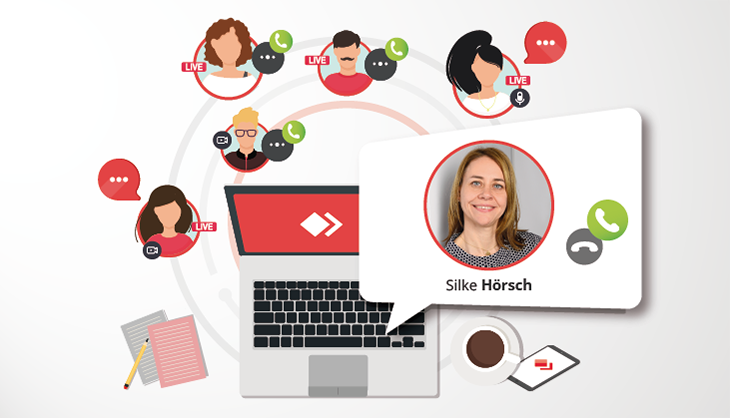The 3 Most Important Tips for Managing Remote Teams

The corona crisis presented us with new challenges. It forced us to rethink old strategies and break new ground in many different areas. The world of work was hit particularly hard, and digitization is advancing at a pace that would have been unthinkable before. Concepts like New Work are becoming more important. Employees work from their homes, where they can organize their working day themselves, but are no longer physically present in the same office. We spoke with Silke Hörsch, Global Director of Marketing and Business Development at AnyDesk, about what it’s like to lead a remote team and why it’s important to adapt management strategies.
For 14 years, Silke been working partly in the office and partly from home and has been leading teams from a distance for almost as long. Before the pandemic, she used her time at home for quiet tasks, while meetings and brainstorming sessions were held in the office. For her, a mix of both is the best way to go.
Suddenly, with the onset of the corona crisis, everything had to be done from home. With these 3 tips, Silke still manages to keep her team together and her employees motivated.
1. Use of technology
There is a big difference between meeting in the office every day and just logging on to the computer from home in the morning. Silke tries to keep this difference as small as possible. The basis are video conferencing and screen sharing tools. “I always show my webcam in meetings and try to get people to show theirs.” But video calls are still not the same as a face-to-face meeting: there is always a slight delay. The short breaks may cause some employees to feel uncomfortable. As a team leader, it’s important to have a trained eye. “Body language and faces are so important.”
Less is more when it comes to tools. It’s best to use a tool that combines several functions instead of many different programs that employees individually need to learn how to use. There is one thing Silke expects from her co-workers: “Tools need to work smoothly, and the team needs to be able to use them correctly. The employees have to be trained. But for everything to run smoothly, each person also has to test their equipment themselves.”
What Silke misses about the physical office is the creativity it cultivates. It’s difficult to capture that outside of the office. “For me, nothing beats personal meetings and gatherings. Whether it’s small coincidences or big ideas, you almost only have these creative moments when you see each other in person.” Tools can help with this problem as well, such as whiteboards that can be edited by several colleagues.
2. Create a structure
If the office is spread across the globe, structure can get lost. Silke knows how to avoid this. “I clearly define everyone’s responsibilities and the quarterly or annual goals. It is important to me that each employee can clearly see the value they generate for the company.” This includes team meetings as well as weekly 1-on-1s. These individual meetings are intended to define where one stands, where their work leads to and how potential problems can be solved. “KPIs and dashboards are also very important to me in order to see successes or failures and to be able to work on improving things.” Silke emphasizes that planning ahead is important. At the same time agility and flexibility are needed and the mindset to adapt quickly to a changing environment.
Meetings are a must for Silke, but she also wants to remain flexible. She deliberately leaves gaps in her daily schedule for spontaneous meetings, where more personal words can be exchanged as well. That way, she reclaims some of the spontaneous creativity of an office. “These meetings often generate the best ideas.”
However, there is also the danger that less communicative employees will isolate themselves apart from the weekly meetings. Silke wants to avoid that. “If I haven’t heard from an employee for a few days, I simply reach out. I get myself a coffee, call them and ask how they are doing. We are all human beings and every now and then a question about family or other private matters is important.”
3. Have confidence in your team
One of the concerns of a manager can be losing control over an employee’s daily tasks. Silke Hörsch has never been a fan of micromanagement. “I cannot and will not control and approve everything.” Employees shouldn’t feel obligated to hand over all decisions to their manager. “For me, the most important element of successful collaboration is to give my team autonomy and decision-making authority. I often get asked to make a decision, but I usually play the ball back and ask, if you were the owner, how would you decide?” In Silke’s eyes, every employee should have this entrepreneurial view and make decisions based on it. “If there are problems, I can always intervene.”
Although personal exchange in the office is still the most important thing to her, Silke does not only see times of crisis as negative. “It’s a good opportunity to consider how best to adapt your personal leadership style for successful cooperation, even beyond the pandemic”.
Not only the pandemic, but also longer-term trends toward globalization and digitization indicate that we need to change the way we manage teams. Silke sees the future in Agile Leadership. “It is important to meet employees at eye level and let them take decisions on their own. That will enable the company to quickly respond to change and stay innovative.” With an agile leader, a team can confidently manage unforeseen events such as a global pandemic, whether they are in the office together or spread across the globe.
Sign up for news, tips and more